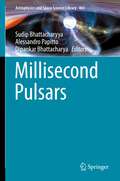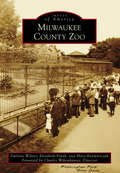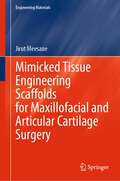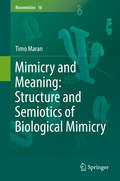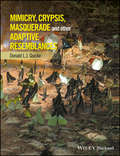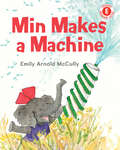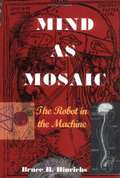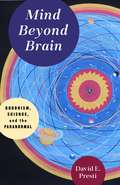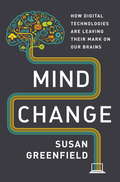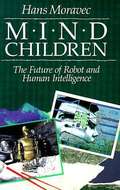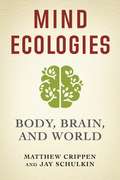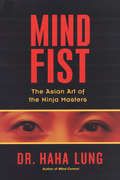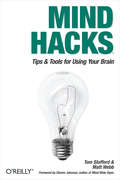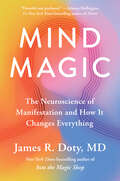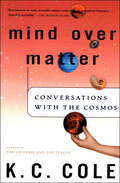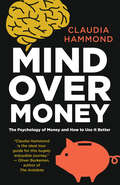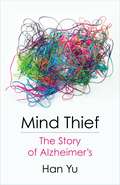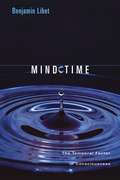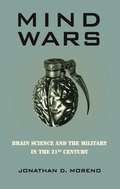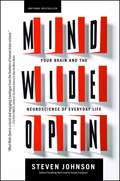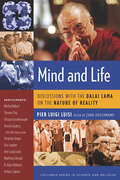- Table View
- List View
Millisecond Pulsars (Astrophysics and Space Science Library #465)
by Dipankar Bhattacharya Sudip Bhattacharyya Alessandro PapittoThis book includes nine chapters written by internationally recognized experts, covering all aspects of millisecond pulsars in one concise and cohesive volume. These aspects include pulsations powered by stellar spin, accretion and thermonuclear burning of accreted matter, their physics and utility, stellar evolution and the extreme physics of super-dense stellar cores. The book includes substantial background material as well as recent theoretical and multi-wavelength observational results. The volume will thus be useful for professional astronomers and graduate students alike.What is the behavior of the strong nuclear interaction, and what are the matter constituents at ultrahigh densities in neutron star cores? How do old neutron stars in binaries evolve? How does their magnetosphere interact with the surrounding plasma to accelerate particles and emit radiation observed at all wavelengths? These are just a few of the questions that millisecond pulsars are helping us answer and will settle in the near future with the next generation of instruments. Such quickly rotating, highly magnetized neutron stars are remarkable natural laboratories that allow us to investigate the fundamental constituents of matter and their interactions under extreme conditions that cannot be reproduced in terrestrial laboratories.
Milwaukee County Zoo
by Elizabeth Frank Darlene Winter Mary KazmierczakFrom the inception of the Milwaukee County Zoo at West Park in 1892, the citizens of Milwaukee have worked diligently to make it one of the finest zoos in the country. Their tireless effort and faith were rewarded. The zoo experienced many firsts, including the first polar bear born in captivity in North America, and was home to Samson, one of the largest gorillas in captivity. Throughout its history, the zoo also gained fame for innovative exhibit design. The zoo has flourished through the cooperation of Milwaukee County and the Zoological Society of Milwaukee. This public-private relationship has existed successfully since 1910.
Mimic Makers: Biomimicry Inventors Inspired by Nature
by Kristen Nordstrom&“Young readers will be captivated by the contemporary inventors and inventions featured, and inspired to incorporate biomimicry into their own designs.&”—Miranda Paul, author of One Plastic Bag and Water is WaterWho's the best teacher for scientists, engineers, AND designers? Mother nature, of course!When an inventor is inspired by nature for a new creation, they are practicing something called biomimicry. Meet ten real-life scientists, engineers, and designers who imitate plants and animals to create amazing new technology. An engineer shapes the nose of his train like a kingfisher's beak. A scientist models her solar cell on the mighty leaf. Discover how we copy nature's good ideas to solve real-world problems!WINNER AAAS/Subaru SB&F Prize for Excellence in Science BooksA National Science Teacher Association Best STEM Book&“Mimic Makers reveals marvels of engineering inspired by nature with images that invite careful observation and explanations that are expressive, but never over simplified.&”—Kim Parfitt, AP Biology and Environmental Science teacher, curriculum developer for Howard Hughes Medical Institute Biointeractive, and recipient of the Presidential Award for Excellence in Science and Math Teaching. &“Amazing! . . . Love that the book features the scientists and inventors, and that there is a diverse set of them. —Janine Benyus, co-founder of the Biomimicry Institute
Mimicked Tissue Engineering Scaffolds for Maxillofacial and Articular Cartilage Surgery (Engineering Materials)
by Jirut MeesaneThis book outlines the latest research on the design and fabrication of the biomaterials used in mimicked scaffolds for tissue engineering for maxillofacial and orthopedic applications. The book is written based on integration and optimized concepts of 3 main parts 1) principle of tissue engineering; 2) mimicking of structure and function of scaffolds which is similar to extracellular matrix (ECM); and 3) mimicked scaffolds for tissue engineering in maxillofacial and orthopedic surgery. The content of this book which is interdisciplinary in nature caters to medical product designers, materials scientists and engineers, biologists, and surgeons who have interest in the field of bone tissue engineering.
Mimicry and Meaning: Structure and Semiotics of Biological Mimicry
by Timo MaranThe present book analyses critically the tripartite mimicry model (consisting of the mimic, model and receiver species) and develops semiotic tools for comparative analysis. It is proposed that mimicry has a double structure where sign relations in communication are in constant interplay with ecological relations between species. Multi-constructivism and toolbox-like conceptual methods are advocated for, as these allow taking into account both the participants' Umwelten as well as cultural meanings related to specific mimicry cases. From biosemiotic viewpoint, mimicry is a sign relation, where deceptively similar messages are perceived, interpreted and acted upon. Focusing on living subjects and their communication opens up new ways to understand mimicry. Such view helps to explain the diversity of mimicry as well as mimicry studies and treat these in a single framework. On a meta-level, a semiotic view allows critical reflection on the use of mimicry concept in modern biology. The author further discusses interpretations of mimicry in contemporary semiotics, analyses mimicry as communicative interaction, relates mimicry to iconic signs and focuses on abstract resemblances in mimicry. Theoretical discussions are illustrated with detailed excursions into practical mimicry cases in nature (brood parasitism, eyespots, myrmecomorphy, etc. ). The book concludes with a conviction that mimicry should be treated in a broader semiotic-ecological context as it presumes the existence of ecological codes and other sign conventions in the ecosystem.
Mimicry, Crypsis, Masquerade and other Adaptive Resemblances
by Donald L. QuickeDeals with all aspects of adaptive resemblance Full colour Covers everything from classic examples of Batesian, Mullerian, aggressive and sexual mimicries through to human behavioural and microbial molecular deceptions Highlights areas where additonal work or specific exeprimentation could be fruitful Includes, animals, plants, micro-organisms and humans
Min Makes a Machine (I Like to Read)
by Emily Arnold McCullyBudding engineer Min uses her skills to save the day in this Level E easy reader, perfect for Kindergarten students to read on their own! Min wants to play, but Ann and Bess say it's too hot to do anything. Min waves a fan, but it doesn't help at all. What's a girl to do? There's a pool, but it's empty—but clever Min finds a nearby well with some water in it. A tube, a hose, some glue, and a good idea later, Min builds a machine to draw water out of the well and into the pool. Splash! Thanks to Min, all the girls can play in the pool! Caldecott Medalist Emily Arnold McCully has created a fun tale about creative problem-solving, with simple text for emerging readers and bright illustrations depicting Min's creation of an Archimedes screw to add extra detail. For more of Min's adventures, check out 3, 2, 1, Go! in which Min builds a catapult. A Junior Library Guild selection! The award-winning I Like to Read® series focuses on guided reading levels A through G, based upon Fountas and Pinnell standards. Acclaimed author-illustrators--including winners of Caldecott, Theodor Seuss Geisel, and Coretta Scott King honors—create original, high quality illustrations that support comprehension of simple text and are fun for kids to read with parents, teachers, or on their own! Level E stories feature a distinct beginning, middle, and end, with kid-friendly illustrations offering clues for more challenging sentences. Varied punctuation and simple contractions may be included. Level E books are suitable for early first graders. When Level E is mastered, follow up with Level F.
Mind And Cosmos: Why The Materialist Neo-darwinian Conception Of Nature Is Almost Certainly False
by Thomas NagelThe modern materialist approach to life has conspicuously failed to explain such central mind-related features of our world as consciousness, intentionality, meaning, and value. This failure to account for something so integral to nature as mind, argues philosopher Thomas Nagel, is a major problem, threatening to unravel the entire naturalistic world picture, extending to biology, evolutionary theory, and cosmology. <p><p> Since minds are features of biological systems that have developed through evolution, the standard materialist version of evolutionary biology is fundamentally incomplete. And the cosmological history that led to the origin of life and the coming into existence of the conditions for evolution cannot be a merely materialist history, either. An adequate conception of nature would have to explain the appearance in the universe of materially irreducible conscious minds, as such. <p> Nagel's skepticism is not based on religious belief or on a belief in any definite alternative. In Mind and Cosmos, he does suggest that if the materialist account is wrong, then principles of a different kind may also be at work in the history of nature, principles of the growth of order that are in their logical form teleological rather than mechanistic. <p> In spite of the great achievements of the physical sciences, reductive materialism is a world view ripe for displacement. Nagel shows that to recognize its limits is the first step in looking for alternatives, or at least in being open to their possibility.
Mind As Mosaic: The Robot In The Machine
by Bruce H. HinrichsMind as Mosaic: The Robot in the Machine is a beguiling introduction to how the mind is created by the brain. With clarity, humor and poetry, Mind as Mosaic mixes history, biology, philosophy, artificial intelligence, and psychology in fresh, cutting-edge and insightful reading.People who drill holes in their heads, cannibals, electrical stimulation of brains, people who are blind but don't know it, and other absorbing and intriguing wonders are presented and explained in an uncompromisingly honest style that is compelling and accessible.Packed with startling and riveting examples and clear explanations of how the mind is robotically formed by brain processes, Mind as Mosaic is science wrapped in humanity, facts laced with wit, philosophy in a white laboratory coat. The subject is not only fun, it is profound.
Mind Beyond Brain: Buddhism, Science, and the Paranormal
by David PrestiAmong the most profound questions we confront are the nature of what and who we are as conscious beings, and how the human mind relates to the rest of what we consider reality. For millennia, philosophers, scientists, and religious thinkers have attempted answers, perhaps none more meaningful today than those offered by neuroscience and by Buddhism. The encounter between these two worldviews has spurred ongoing conversations about what science and Buddhism can teach each other about mind and reality.In Mind Beyond Brain, the neuroscientist David E. Presti, with the assistance of other distinguished researchers, explores how evidence for anomalous phenomena—such as near-death experiences, apparent memories of past lives, apparitions, experiences associated with death, and other so-called psi or paranormal phenomena, including telepathy, clairvoyance, and precognition—can influence the Buddhism-science conversation. Presti describes the extensive but frequently unacknowledged history of scientific investigation into these phenomena, demonstrating its relevance to questions about consciousness and reality. The new perspectives opened up, if we are willing to take evidence of such often off-limits topics seriously, offer significant challenges to dominant explanatory paradigms and raise the prospect that we may be poised for truly revolutionary developments in the scientific investigation of mind. Mind Beyond Brain represents the next level in the science and Buddhism dialogue.
Mind Change
by Susan GreenfieldWe live in a world unimaginable only decades ago: a domain of backlit screens, instant information, and vibrant experiences that can outcompete dreary reality. Our brave new technologies offer incredible opportunities for work and play. But at what price? Now renowned neuroscientist Susan Greenfield--known in the United Kingdom for challenging entrenched conventional views--brings together a range of scientific studies, news events, and cultural criticism to create an incisive snapshot of "the global now." Disputing the assumption that our technologies are harmless tools, Greenfield explores whether incessant exposure to social media sites, search engines, and videogames is capable of rewiring our brains, and whether the minds of people born before and after the advent of the Internet differ. Stressing the impact on Digital Natives--those who've never known a world without the Internet--Greenfield exposes how neuronal networking may be affected by unprecedented bombardments of audiovisual stimuli, how gaming can shape a chemical landscape in the brain similar to that in gambling addicts, how surfing the Net risks placing a premium on information rather than on deep knowledge and understanding, and how excessive use of social networking sites limits the maturation of empathy and identity. But Mind Change also delves into the potential benefits of our digital lifestyle. Sifting through the cocktail of not only threat but opportunity these technologies afford, Greenfield explores how gaming enhances vision and motor control, how touch tablets aid students with developmental disabilities, and how political "clicktivism" foments positive change. In a world where adults spend ten hours a day online, and where tablets are the common means by which children learn and play, Mind Change reveals as never before the complex physiological, social, and cultural ramifications of living in the digital age. A book that will be to the Internet what An Inconvenient Truth was to global warming, Mind Change is provocative, alarming, and a call to action to ensure a future in which technology fosters--not frustrates--deep thinking, creativity, and true fulfillment.Praise for Mind Change "This is just the book we need now as we proceed to absorb fresh digital innovations: a scientific review of their effects on the brain and what they mean for our minds. Mind Change clearly presents to lay readers the latest experimental findings as Susan Greenfield brings to the digital revolution just the right level of skepticism and curiosity. Neither a naysayer nor an enthusiast, she is a sober, reliable, and engaging voice on screen experience, telling us what happens inside our heads each time we log on, connect, play, and emote."--Mark Bauerlein, author of The Dumbest Generation: How the Digital Age Stupefies Young Americans and Jeopardizes Our Future (Or, Don't Trust Anyone Under 30) "Greenfield's Mind Change . . . proposes that global climate change can serve as a useful metaphor for how human minds--our inner environments--are, in her view, being recklessly altered by digital technologies. . . . Mind Change is an important presentation of an uncomfortable minority position."--Jaron Lanier, Nature "Greenfield is a lucid and thorough communicator, and this book is highly accessible to those with no knowledge of neuroscience. . . . That I kept being distracted from my reading to check Facebook was less a reflection on the quality of the book than a sobering lesson in how relevant these issues are."--The Independent (U.K.)From the Hardcover edition.
Mind Children: The Future of Robot and Human Intelligence
by Hans MoravecArguing that within the next fifty years machines will equal humans not only in reasoning power but also in their ability to perceive, interact with, and change their environment, the author describes the tremendous technological advances possible in thefield of robotics.
Mind Ecologies: Body, Brain, and World
by Jay Schulkin Matthew CrippenPragmatism—a pluralistic philosophy with kinships to phenomenology, Gestalt psychology, and embodied cognitive science—is resurging across disciplines. It has growing relevance to literary studies, the arts, and religious scholarship, along with branches of political theory, not to mention our understanding of science. But philosophies and sciences of mind have lagged behind this pragmatic turn, for the most part retaining a central-nervous-system orientation, which pragmatists reject as too narrow.Matthew Crippen, a philosopher of mind, and Jay Schulkin, a behavioral neuroscientist, offer an innovative interdisciplinary theory of mind. They argue that pragmatism in combination with phenomenology is not only able to give an unusually persuasive rendering of how we think, feel, experience, and act in the world but also provides the account most consistent with current evidence from cognitive science and neurobiology. Crippen and Schulkin contend that cognition, emotion, and perception are incomplete without action, and in action they fuse together. Not only are we embodied subjects whose thoughts, emotions, and capacities comprise one integrated system; we are living ecologies inseparable from our surroundings, our cultures, and our world. Ranging from social coordination to the role of gut bacteria and visceral organs in mental activity, and touching upon fields such as robotics, artificial intelligence, and plant cognition, Crippen and Schulkin stress the role of aesthetics, emotions, interests, and moods in the ongoing enactment of experience. Synthesizing philosophy, neurobiology, psychology, and the history of science, Mind Ecologies offers a broad and deep exploration of evidence for the embodied, embedded, enacted, and extended nature of mind.
Mind Fist: The Asian Art of the Ninja Masters
by Lung Dr HahaInside every human being is a sleeping tiger--a raw, untapped power that once harnessed, can repel aggressors of any kind. . . In this masterful book, Dr. Haha Lung draws on the psychological origins of ancient Chinese philosophies, explores the fist fighting traditions of Chinese Kung-fu from its birth in ancient India and introduces the extraordinary concept of the Mind Fist--the mental punch you never see coming! Ranging from nonviolent counterattacks to multiple devastating martial arts techniques, this book includes: Mental and physical exercises to strengthen the mind and body Secrets of moshuh-nanren, the Chinese ninja! Understanding the ways of bullies and aggressors How to prevent violence using Zhenkin, the Art of Control Three kinds of force with which you can win physical battle How fear can be turned into focus Ghost strikes and takedowns Mind Fist brilliantly unlocks an ancient skill of true, permanent self-defense--for any aspect of your life! For academic study only Dr. Haha Lung is the author of more than a dozen books on martial arts, including Assassin!, Mind Manipulation, Ninja Shadowhand, Knights of Darkness, Mind Control: The Ancient Art of Psychological Warfare, and The Lost Fighting Arts of Vietnam.
Mind Hacks: Tips & Tricks for Using Your Brain
by Tom Stafford Matt WebbThe brain is a fearsomely complex information-processing environment--one that often eludes our ability to understand it. At any given time, the brain is collecting, filtering, and analyzing information and, in response, performing countless intricate processes, some of which are automatic, some voluntary, some conscious, and some unconscious.Cognitive neuroscience is one of the ways we have to understand the workings of our minds. It's the study of the brain biology behind our mental functions: a collection of methods--like brain scanning and computational modeling--combined with a way of looking at psychological phenomena and discovering where, why, and how the brain makes them happen.Want to know more? Mind Hacks is a collection of probes into the moment-by-moment works of the brain. Using cognitive neuroscience, these experiments, tricks, and tips related to vision, motor skills, attention, cognition, subliminal perception, and more throw light on how the human brain works. Each hack examines specific operations of the brain. By seeing how the brain responds, we pick up clues about the architecture and design of the brain, learning a little bit more about how the brain is put together.Mind Hacks begins your exploration of the mind with a look inside the brain itself, using hacks such as "Transcranial Magnetic Stimulation: Turn On and Off Bits of the Brain" and "Tour the Cortex and the Four Lobes." Also among the 100 hacks in this book, you'll find:Release Eye Fixations for Faster ReactionsSee Movement When All is StillFeel the Presence and Loss of AttentionDetect Sounds on the Margins of CertaintyMold Your Body SchemaTest Your HandednessSee a Person in Moving LightsMake Events Understandable as Cause-and-EffectBoost Memory by Using ContextUnderstand Detail and the Limits of AttentionSteven Johnson, author of "Mind Wide Open" writes in his foreword to the book, "These hacks amaze because they reveal the brain's hidden logic; they shed light on the cheats and shortcuts and latent assumptions our brains make about the world." If you want to know more about what's going on in your head, then Mind Hacks is the key--let yourself play with the interface between you and the world.
Mind Magic: The Neuroscience of Manifestation and How It Changes Everything
by James R. DotyA deep exploration of the neuroscience behind manifestation, with a six-part plan for realizing your dreamsFor decades the practice of manifestation has been widely dismissed as self-involved, materialistic pseudoscience. But as neuroscientist and recognized compassion leader Dr. James Doty reveals, manifestation introduces us to different possibilities, and it lays the groundwork for a kinder, better world. Doty grounds us in the practices that change our brain structures: attention, meditation, visualization, and compassion. This mind magic allows us to move through the world in ways that help us see clearly—reclaiming our agency, realizing our dreams, and reaching out to help others along the path. Where previous works about manifestation have focused narrowly on outward success and individual benefit, Mind Magic delivers an openhearted call to make manifestation part of a deeper contribution to healing the problems we face today.
Mind Over Matter: Conversations with the Cosmos
by K. C. ColeK. C. Cole, the Los Angeles Times science writer and columnist, always has a fresh take on cutting-edge scientific discoveries, which she makes both understandable and very human. Reporting on physics, cosmology, mathematics, astronomy, and more, Cole's essays, culled from her popular Mind Over Matter columns, reveal the universe as simple, constant, and complex--and wholly relevant to politics, art, and every dimension of human life.
Mind Over Money: The Psychology of Cash and How to Use It Better
by Claudia HammondOn a summer evening in 1994, the two members of the band KLF burned £1 million in £50 notes in a barn on the Isle of Jura. They filmed themselves tossing the bills into the fire, and made the story public. The reaction amazed them: this act of nihilism caused a public outpouring of rage. They received death threats. And yet, if the band members had squandered their wealth away on designer clothes and sports cars, would anyone have cared?We constantly make assumptions about money. We confuse it with morality. We know we need it, and we tend to want more of it, but what we do not always appreciate are the ways it affects our minds, and emotions, and can even skew our perceptions.Mind Over Money is about what money does to us. In delightfully accessible language, Hammond explores the power of money and shows how psychology and neuroscience are providing us with some extraordinary tools for making better decisions about the way we use money.
Mind Thief: The Story of Alzheimer's
by Han YuAlzheimer’s disease, a haunting and harrowing ailment, is one of the world’s most common causes of death. Alzheimer’s lingers for years, with patients’ outward appearance unaffected while their cognitive functions fade away. Patients lose the ability to work and live independently, to remember and recognize. There is still no proven way to treat Alzheimer’s because its causes remain unknown.Mind Thief is a comprehensive and engaging history of Alzheimer’s that demystifies efforts to understand the disease. Beginning with the discovery of “presenile dementia” in the early twentieth century, Han Yu examines over a century of research and controversy. She presents the leading hypotheses for what causes Alzheimer’s; discusses each hypothesis’s tangled origins, merits, and gaps; and details their successes and failures. Yu synthesizes a vast amount of medical literature, historical studies, and media interviews, telling the gripping stories of researchers’ struggles while situating science in its historical, social, and cultural contexts. Her chronicling of the trajectory of Alzheimer’s research deftly balances rich scientific detail with attention to the wider implications. In narrating the attempts to find a treatment, Yu also offers a critical account of research and drug development and a consideration of the philosophy of aging. Wide-ranging and accessible, Mind Thief is an important book for all readers interested in the challenge of Alzheimer’s.
Mind Time: The Temporal Factor in Consciousness (Perspectives in Cognitive Neuroscience)
by Benjamin LibetOur subjective inner life is what really matters to us as human beings--and yet we know relatively little about how it arises. Over a long and distinguished career Benjamin Libet has conducted experiments that have helped us see, in clear and concrete ways, how the brain produces conscious awareness. For the first time, Libet gives his own account of these experiments and their importance for our understanding of consciousness. Most notably, Libet's experiments reveal a substantial delay--the "mind time" of the title--before any awareness affects how we view our mental activities. If all conscious awarenesses are preceded by unconscious processes, as Libet observes, we are forced to conclude that unconscious processes initiate our conscious experiences. Freely voluntary acts are found to be initiated unconsciously before an awareness of wanting to act--a discovery with profound ramifications for our understanding of free will. How do the physical activities of billions of cerebral nerve cells give rise to an integrated conscious subjective awareness? How can the subjective mind affect or control voluntary actions? Libet considers these questions, as well as the implications of his discoveries for the nature of the soul, the identity of the person, and the relation of the non-physical subjective mind to the physical brain that produces it. Rendered in clear, accessible language, Libet's experiments and theories will allow interested amateurs and experts alike to share the experience of the extraordinary discoveries made in the practical study of consciousness.
Mind Wars
by Jonathan D. Moreno"One of the most important thinkers describes the literally mind-boggling possibilities that modern brain science could present for national security." -LAWRENCE J. KORB, former US Assistant Secretary of Defense"Fascinating and frightening." -Bulletin of the Atomic ScientistsThe first book of its kind, Mind Wars covers the ethical dilemmas and bizarre history of cutting-edge technology and neuroscience developed for military applications. As the author discusses the innovative Defense Advanced Research Projects Agency (DARPA) and the role of the intelligence community and countless university science departments in preparing the military and intelligence services for the twenty-first century, he also charts the future of national security.Fully updated and revised, this edition features new material on deep brain stimulation, neuro hormones, and enhanced interrogation. With in-depth discussions of "psyops" mind control experiments, drugs that erase both fear and the need to sleep, microchip brain implants and advanced prosthetics, supersoldiers and robot armies, Mind Wars may read like science fiction or the latest conspiracy thriller, but its subjects are very real and changing the course of modern warfare.Jonathan D. Moreno has been a senior staff member for three presidential advisory commissions and has served on a number of Pentagon advisory committees. He is an ethics professor at the University of Pennsylvania and the editor-in-chief of the Center for American Progress' online magazine Science Progress.
Mind Wide Open: Your Brain and the Neuroscience of Everyday Life
by Steven JohnsonBRILLIANTLY EXPLORING TODAY'S CUTTING-EDGE BRAIN RESEARCH, MIND WIDE OPEN IS AN UNPRECEDENTED JOURNEY INTO THE ESSENCE OF HUMAN PERSONALITY, ALLOWING R<P>EADERS TO UNDERSTAND THEMSELVES AND THE PEOPLE IN THEIR LIVES AS NEVER BEFORE. Using a mix of experiential reportage, personal storytelling, and fresh scientific discovery, Steven Johnson describes how the brain works -- its chemicals, structures, and subroutines -- and how these systems connect to the day-to-day realities of individual lives. For a hundred years, he says, many of us have assumed that the most powerful route to self-knowledge took the form of lying on a couch, talking about our childhoods. The possibility entertained in this book is that you can follow another path, in which learning about the brain's mechanics can widen one's self-awareness as powerfully as any therapy or meditation or drug. <P> In Mind Wide Open, Johnson embarks on this path as his own test subject, participating in a battery of attention tests, learning to control video games by altering his brain waves, scanning his own brain with a $2 million fMRI machine, all in search of a modern answer to the oldest of questions: who am I? <P> Along the way, Johnson explores how we "read" other people, how the brain processes frightening events (and how we might rid ourselves of the scars those memories leave), what the neurochemistry is behind love and sex, what it means that our brains are teeming with powerful chemicals closely related to recreational drugs, why music moves us to tears, and where our breakthrough ideas come from. <P> Johnson's clear, engaging explanation of the physical functions of the brain reveals not only the broad strokes of our aptitudes and fears, our skills and weaknesses and desires, but also the momentary brain phenomena that a whole human life comprises. Why, when hearing a tale of woe, do we sometimes smile inappropriately, even if we don't want to? Why are some of us so bad at remembering phone numbers but brilliant at recognizing faces? Why does depression make us feel stupid? <P> To read Mind Wide Open is to rethink family histories, individual fates, and the very nature of the self, and to see that brain science is now personally transformative -- a valuable tool for better relationships and better living.
Mind and Brain: The Many-Faceted Problems
by John EcclesA collection of philosophical and scientific papers illustrating diverse viewpoints on the mind-body problem.
Mind and Life: Discussions with the Dalai Lama on the Nature of Reality (Columbia Series in Science and Religion)
by Pier Luigi LuisiScientists, philosophers and Buddhist scholars discuss the nature of reality in a book that goes inside a Mind and Life Institute conference.For over a decade, members of the Mind and Life Institute have gathered to discuss questions that are both fundamental and profound: can physics, chemistry, and biology explain the mystery of life? How do our philosophical assumptions influence science and the ethics we bring to biotechnology? And how does an ancient spiritual tradition throw new light on these questions? In Mind and Life, Pier Luigi Luisi reproduces this stimulating cross-cultural dialogue in which world-class scientists, philosophers, and Buddhist scholars develop a holistic approach to the exploration of reality. He also adds scientific background to their presentations, as well as supplementary discussions with prominent participants and attendees. Interviews with His Holiness the Karmapa, the Buddhist monk Matthieu Ricard, and the actor and longtime human rights advocate Richard Gere further enrich the material with personal viewpoints. Conversation topics range from the origin of matter to the nature of evolution, the ethics of genetic manipulation, and the question of consciousness and ethics.
Mind and Life: Discussions with the Dalai Lama on the Nature of Reality (Columbia Series in Science and Religion)
by Pier LuisiFor over a decade, a small group of scientists and philosophers-members of the Mind and Life Institute-have met regularly to explore the intersection between science and the spirit. At one of these meetings, the themes discussed were both fundamental and profound: can physics, chemistry, and biology explain the mystery of life? How do our philosophical assumptions influence science and the ethics we bring to biotechnology? And how does an ancient spiritual tradition throw new light on these questions?Pier Luigi Luisi not only reproduces this dramatic, cross-cultural dialogue, in which world-class scientists, philosophers, and Buddhist scholars develop a holistic approach to the scientific exploration of reality, but also adds scientific background to their presentations, as well as supplementary discussions with prominent participants and attendees. Interviews with His Holiness the Karmapa, the Buddhist monk Matthieu Ricard, and the actor and longtime human rights advocate Richard Gere take the proceedings into new directions, enriching the material with personal viewpoints and lively conversation about such topics as the origin of matter, the properties of cells, the nature of evolution, the ethics of genetic manipulation, and the question of consciousness and ethics. A keen study of character, Luisi incorporates his own amusing observations into this fascinating dialogue, painting a very human portrait of some of our greatest-and most intimidating-thinkers. Deeply textured and cleverly crafted, Mind and Life is an excellent opportunity for any reader to join in the debate surrounding this cutting-edge field of inquiry.
